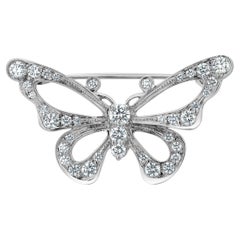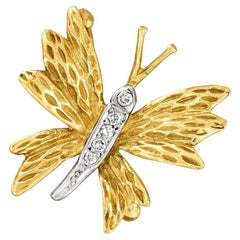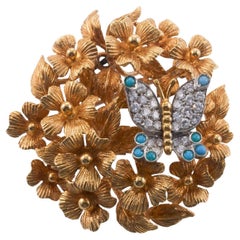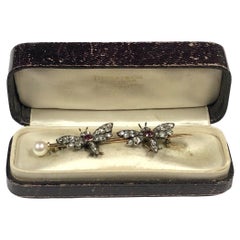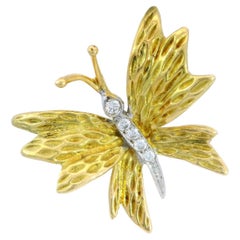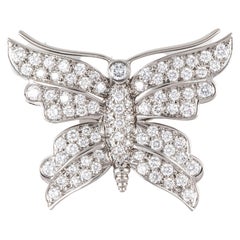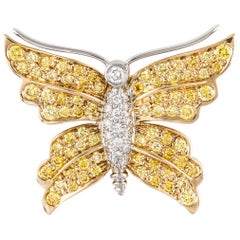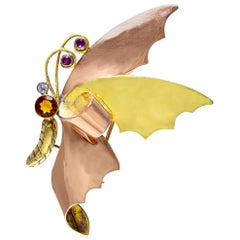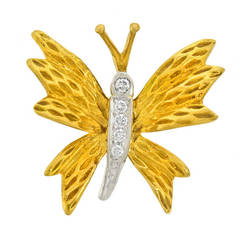Tiffany Diamond Butterfly Brooch
20th Century American Contemporary Brooches
Diamond, Platinum
2010s American Brooches
Diamond, 18k Gold, Platinum
20th Century American Brooches
Diamond, Turquoise, Gold, Platinum
Antique Early 1900s American Late Victorian Brooches
Diamond, Ruby, 14k Gold, Silver
21st Century and Contemporary Modern Brooches
Diamond, Gold, 18k Gold, Yellow Gold
Late 20th Century American Brooches
Diamond, Platinum
Late 20th Century American Brooches
Diamond, Yellow Diamond, 18k Gold, Platinum
Recent Sales
Vintage 1930s American Brooches
Citrine, Diamond, Ruby, 14k Gold
Vintage 1980s American Brooches
Diamond, Platinum, 18k Gold
20th Century American Modern Brooches
Diamond, Platinum
1990s American Brooches
Diamond, Platinum, 18k Gold
21st Century and Contemporary American Contemporary Brooches
Diamond, Platinum
Vintage 1960s Brooches
White Diamond, Emerald, Opal, Gold, 18k Gold, Yellow Gold
Vintage 1940s Unknown Retro Brooches
Diamond, 18k Gold
Vintage 1980s Unknown Modern Brooches
Diamond, Platinum
Vintage 1960s Italian Brooches
Diamond, Sapphire, 14k Gold, Yellow Gold
Vintage 1980s Contemporary Brooches
Diamond, White Diamond, Emerald, Sapphire, Blue Sapphire, Yellow Gold, G...
1990s American Brooches
Diamond, Platinum
20th Century American Artisan Brooches
Diamond, 18k Gold, Yellow Gold
20th Century Brooches
Diamond, Yellow Gold
Vintage 1980s American Contemporary Brooches
Diamond, Tsavorite, Gold, 18k Gold, White Gold, Yellow Gold
21st Century and Contemporary Brooches
Diamond, Platinum
American Brooches
Early 2000s Contemporary Brooches
Diamond, Peridot, 18k Gold, Yellow Gold, Platinum
1990s American Brooches
Platinum
Vintage 1980s American Brooches
Diamond, Blue Sapphire, 18k Gold
21st Century and Contemporary Unknown Modern Brooches
Diamond, 18k Gold, Platinum
Mid-20th Century Brooches
Diamond, 18k Gold, White Gold, Yellow Gold
People Also Browsed
2010s Wrist Watches
1990s French Evening Gowns
Early 2000s French Cocktail Dresses
1990s Drop Necklaces
Garnet, Rhodolite, 18k Gold
Vintage 1970s Italian Drop Necklaces
Diamond, Emerald, 18k Gold
21st Century and Contemporary Cuff Bracelets
1990s American Retro Brooches
Ruby, 18k Gold, Yellow Gold, Enamel
Vintage 1950s American Modernist Brooches
Diamond, Sapphire, 14k Gold, Yellow Gold
Vintage 1960s American Drop Earrings
Diamond, Emerald, Platinum
21st Century and Contemporary Brooches
18k Gold, Yellow Gold
21st Century and Contemporary Top Handle Bags
Antique Late 19th Century European Victorian Brooches
Diamond, Natural Pearl, 18k Gold, Silver
Early 2000s American Choker Necklaces
Diamond, Cultured Pearl, Platinum
Antique 1880s English Victorian Brooches
Pearl, Ruby, Natural Pearl, Gold, 14k Gold, Yellow Gold
1990s French Modernist Hoop Earrings
Gold, 18k Gold, Rose Gold, White Gold, Yellow Gold
20th Century French Brooches
Gilt Metal
Tiffany Diamond Butterfly Brooch For Sale on 1stDibs
How Much is a Tiffany Diamond Butterfly Brooch?
Tiffany & Co. for sale on 1stDibs
Tiffany & Co. is one of the most prominent purveyors of luxury goods in the United States, and has long been an important arbiter of style in the design of diamond engagement rings. A young Franklin Delano Roosevelt proposed to his future wife, Eleanor, with a Tiffany ring in 1904. Vanderbilts, Whitneys, Astors and members of the Russian imperial family all wore Tiffany & Co. jewelry. And Jacqueline Kennedy Onassis preferred Tiffany china for state dinners at the White House.
Although synonymous with luxury today, the firm started out rather modestly. Charles Lewis Tiffany and John B. Young founded it in Connecticut as a “stationery and fancy goods emporium” in 1837, at a time when European imports still dominated the nascent American luxury market. In 1853, Charles Tiffany — who in 1845 had launched the company’s famed catalog, the Blue Book, and with it, the firm’s signature robin’s-egg blue, which he chose for the cover — shifted the focus to fine jewelry.
In 1868, Tiffany & Co. gained international recognition when it became the first U.S. firm to win an award for excellence in silverware at the Exposition Universelle in Paris. From then on, it belonged to the pantheon of American luxury brands.
At the start of the Gilded Age, in 1870, Tiffany & Co. opened its flagship store, described as a "palace of jewels" by the New York Times, at 15 Union Square West in Manhattan. Throughout this period, its designs for silver tableware, ceremonial silver, flatware and jewelry were highly sought-after indicators of status and taste. They also won the firm numerous accolades, including the grand prize for silverware at the Paris Exposition of 1878. Among the firm’s glittering creations from this time are masterworks of Art Nouveau jewelry, such as this delicate aquamarine necklace and this lavish plique-à-jour peridot and gold necklace, both circa 1900.
When Charles Lewis Tiffany died, in 1902, his son Louis Comfort Tiffany became the firm’s design director. Under his leadership, the Tiffany silver studio was a de facto design school for apprentice silversmiths, who worked alongside head artisan Edward C. Moore. The firm produced distinctive objects inspired by Japanese art and design, North American plants and flowers, and Native American patterns and crafts, adding aesthetic diversity to Tiffany & Co.’s distinguished repertoire.
Tiffany is also closely associated with diamonds, even lending its name to one particularly rare and exceptional yellow stone. The firm bought the Tiffany diamond in its raw state from the Kimberley mines of South Africa in 1878. Cut to create a 128.54-carat gem with an unprecedented 82 facets, it is one of the most spectacular examples of a yellow diamond in the world.
In a broader sense, Tiffany & Co. helped put diamonds on the map in 1886 by introducing the American marketplace to the solitaire diamond design, which is still among the most popular engagement-ring styles. The trademark Tiffany® Setting raises the stone above the band on six prongs, allowing its facets to catch the light. A lovely recent example is this circa-2000 platinum engagement ring. Displaying a different design and aesthetic (but equally chic) is this exquisite diamond and ruby ring from the 1930s.
Find Tiffany & Co. jewelry, serveware and decorative objects for sale on 1stDibs.
The Legacy of Diamond in Jewelry Design
Antique diamond rings, diamond tiaras and dazzling vintage diamond earrings are on the wish lists of every lover of fine jewelry. And diamonds and diamond jewelry are primarily associated with storybook engagements and red-carpet grand entrances — indeed, this ultra-cherished gemstone has a dramatic history on its hands.
From “A Diamond Is Forever” to “Diamonds Are a Girl’s Best Friend,” pop culture has ingrained in our minds that diamonds are the most desired, the most lasting and the most valuable gemstone. But what makes the diamond so special? Each stone — whether it’s rubies, sapphires or another stone — is unique and important in its own right. April babies might claim diamonds for themselves, but just about everyone wants this kind of sparkle in their lives!
There are several factors that set diamonds apart from other stones, and these points are important to our gem education.
Diamonds are minerals. They are made up of almost entirely of carbon (carbon comprises 99.95 percent; the remainder consists of various trace elements). Diamonds are the hardest gemstones, ranking number 10 on the Mohs Hardness Scale. Even its name, diamond, is rooted in the Greek adamas, or unconquerable. The only object that can scratch a diamond is another diamond. Diamonds are formed deep within the earth at very high temperatures (1,652–2,372 degrees Fahrenheit at depths between 90 and 120 miles beneath the earth’s surface) and are carried up by volcanic activity. Diamonds are quite rare, according to the Gemological Institute of America, and only 30 percent of all the diamonds mined in the world are gem quality.
In the 1950s, the Gemological Institute of America developed the 4Cs grading system to classify diamonds: clarity, color, cut and carat weight. Not all diamonds are created equal (there are diamonds, and then there are diamonds). The value of the diamond depends on the clarity (flawless diamonds are very rare but a diamond's value decreases if there are many blemishes or inclusions), color (the less color the higher the grade), cut (how the diamond’s facets catch the light, certain cuts of diamonds show off the stone better than others) and carat weight (the bigger, the better).
When you start shopping for a diamond engagement ring, always prioritize the cut, which plays the largest role in the diamond's beauty (taking the time to clean your diamond ring at least every six months or so plays a role in maintaining said beauty). And on 1stDibs, a range of buying guides can be found for those in the market for antique engagement rings, vintage engagement rings or Art Deco engagement rings.
Shop antique and vintage diamond rings, diamond necklaces and other extraordinary diamond jewelry on 1stDibs.
Finding the Right Brooches for You
Vintage brooches, which refer to decorative jewelry traditionally pinned to garments and used to fasten pieces of clothing together where needed, have seen increasing popularity in recent years.
While jewelry trends come and go, brooches are indeed back on the radar thanks to fashion houses like Gucci, Versace, Dior and Saint Laurent, all of which feature fun pinnable designs in their current collections. Whether a dazzlingly naturalistic Art Nouveau dragonfly, a whimsical David Webb animal, a gem-studded bloom or a streamlined abstract design, these jewels add color and sparkle to your look and a spring to your step.
Given their long history, brooches have expectedly taken on a variety of different shapes and forms over time, with jewelers turning to assorted methods of ornamentation for these accessories, including enameling and the integration of pearls and gemstones. Cameo brooches that originated during the Victorian age are characterized by a shell carved in raised relief that feature portraits of a woman’s profile, while 19th-century micromosaic brooches, comprising innumerable individually placed glass fragments, sometimes feature miniature depictions of a pastoral scene in daily Roman life.
At one time, brooches were symbols of wealth, made primarily from the finest metals and showcasing exquisite precious gemstones. Today, these jewels are inclusive and universal, and you don’t have to travel very far to find an admirer of brooches. They can be richly geometric in form, such as the ornate diamond pins dating from the Art Deco era, or designer-specific, such as the celebrated naturalistic works created by Tiffany & Co., the milk glass and gold confections crafted by Trifari or handmade vintage Chanel brooches of silk or laminated sheer fabric. Chanel, of course, has never abandoned this style, producing gorgeously baroque CC examples since the 1980s.
Brooches are versatile and adaptable. These decorative accessories can be worn in your hair, on hats, scarves and on the lower point of V-neck clothing. Pin a dazzling brooch to the lapel of your blazer-and-tee combo or add a cluster of smaller pins to your overcoat. And while brooches have their place in “mourning jewelry,” in that a mourning brooch is representative of your connection to a lost loved one, they’re widely seen as romantic and symbolic of love, so much so that a hardcore brooch enthusiast might advocate for brooches to be worn over the heart.
Today, find a wide variety of antique and vintage brooches for sale on 1stDibs, including gold brooches, sapphire brooches and more.
- 1stDibs ExpertAugust 17, 2021A Tiffany & Co. engagement ring can cost as little as $13,000 or as much as $500,000 depending on the center stone’s carat weight, the band material and whether or not there are any side stones. The smaller the stone, the cheaper the ring will be. Find engagement rings designed by Tiffany & Co. on 1stDibs.
